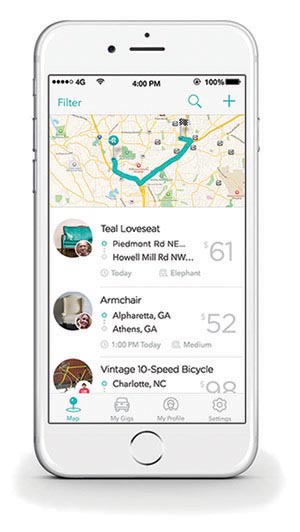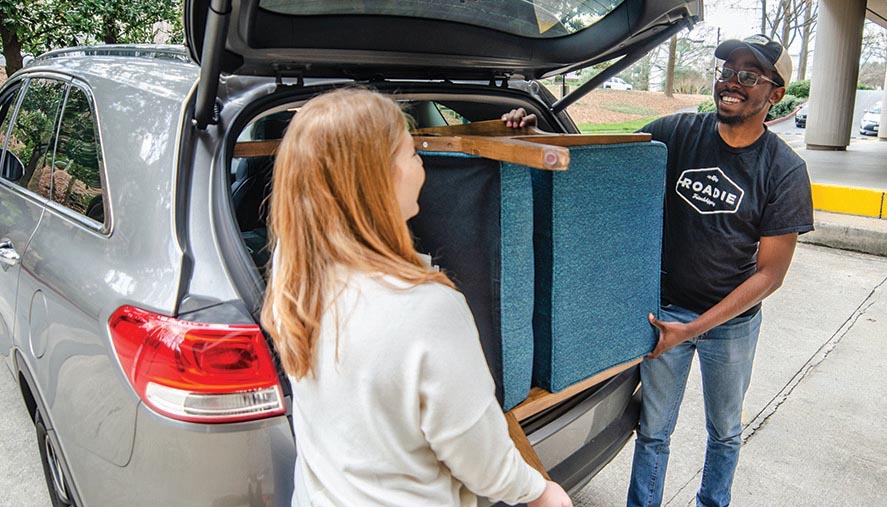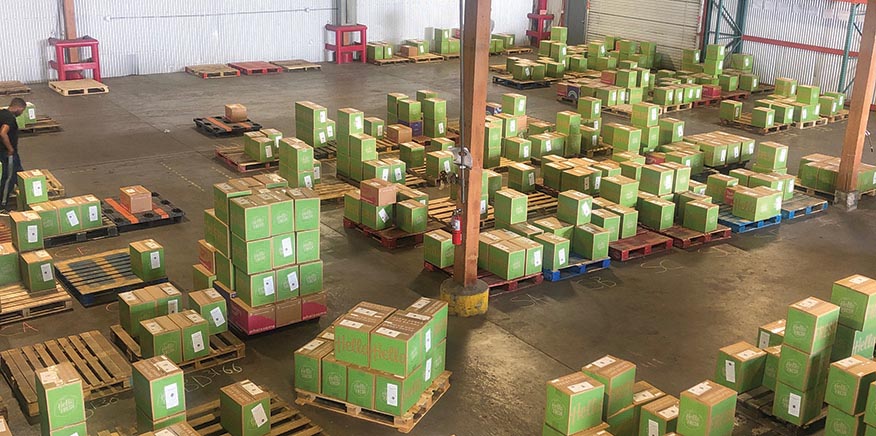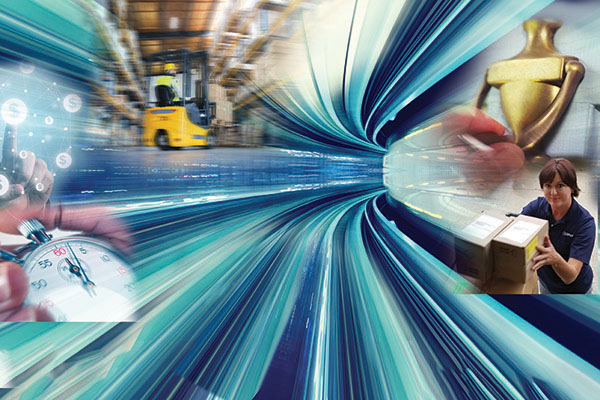The Big Picture: On-Demand Delivery on Your Doorstep
The latest iteration of last-mile delivery is rapidly changing not just how quickly we take delivery of our latest purchase, but the picking and packing of orders in the distribution center.
Not so long ago (pre-smartphone to be precise), we were just happy when a package arrived. We didn’t always expect it any particular day. We weren’t always sure if it would come through the post office or some other parcel service. In the end, none of that mattered. It was just exciting to get delivery.
So much for such laissez-faire delivery. We are now in the age of on-demand delivery.
For food, that’s in the next hour or less. For grocery, two hours is good. For other online purchases, same day is powerful, too. And now, Amazon says its Prime two-day delivery is in the process of becoming next-day delivery. These are all variants of on-demand delivery.
“People want what they want when they want it,” explains Valerie Metzker, head of business development at delivery service Roadie. What consumers think is possible is constantly changing.
Did you hear that after years of talk, Amazon finally has clearance to test drone deliveries? Or, that Amazon and Kroger are testing small autonomous vehicles for delivery to your front door? It won’t stop there.
“Delivery is not a fad,” explained David Mell of RBC Capital Markets to The Wall Street Journal last October. So true. There’s even a trade show dedicated to the subject—Home Delivery World. If you’re interested, the 2020 version is in Philadelphia the first week of June.
And, almost everyone is interested in on-demand delivery. Joe’s Pizza Palace is just as captivated by it as Target, Walmart, Amazon, Nordstrom and most every other purveyor of goods in between.
Buckle up. On-demand delivery is not just about getting something to the consumer pronto, it’s also having an impact on how distribution centers operate.
Last mile or on-demand?
 Until recently, last-mile delivery was the great conundrum. How does a package move that last, final distance to its destination most efficiently? The congestion and compactness of urban areas create different physical challenges than rural deliveries. But regardless of geography, the central issues are the same: cost and time.
Until recently, last-mile delivery was the great conundrum. How does a package move that last, final distance to its destination most efficiently? The congestion and compactness of urban areas create different physical challenges than rural deliveries. But regardless of geography, the central issues are the same: cost and time.
In fact, cost and time are two sides of the same coin in last-mile delivery. The shipper wants to deliver at the least cost to them. That’s paramount. And to reduce cost, that typically means delivering in the shortest time. However, route optimization can require extra time to complete the delivery in some cases. That’s OK since the customer’s expectations for the arrival of the delivery have long been relatively soft.
Enter on-demand delivery. It is clearly a subset of the last mile, but it is a different game with a different center of gravity—the consumer not the shipper.
“On-demand delivery is all about the timing. This is the No. 1 differentiator of on-demand from last-mile delivery,” explains Barb Ivanov, director Urban Freight Lab at the University of Washington.
“The customer now expects delivery in a tightly defined window of a few hours,” explains Ben Harris, director of supply chain for the Metro Atlanta Chamber.
Customer experience is the second key differentiator of on-demand from the last mile, explains Ivanov. In fact, delivery metrics have now become a top measure of consumer satisfaction.
The customer experience has also added a new dimension to determine the tradeoffs between costs and time in deliveries. This is the third difference, says Ivanov. “Last-mile is primarily about optimizing routes. With one- to two-hour, on-demand deliveries, there are no pre-set routes. The route gets determined when something is ordered and when it needs to be delivered,” she adds.
The ascension of the customer experience with on demand does not minimize the importance of costs, says Daniel Sokolovsky, founder and CEO of AxleHire. As it turns out, costs are a key point of contention with on demand.
Blame it on Amazon, if you need a scapegoat. No one wants to pay a bill for delivery of any sort. Yet, someone must absorb that cost, explains Sokolovsky. “Delivery costs in on-demand are increasing. Not just the cost of moving the goods but the labor costs of the people making the delivery. Delivery companies cannot continue to subsidize the cost of deliveries. Consumers will need to foot that bill,” he says.
That will be a flashpoint for on-demand delivery for the foreseeable future and has already had an impact. Sokolovsky says that the cost issue is why venture capitalists are less enthralled with on-demand delivery companies than they once were. That said, on-demand delivery is thriving none the less.

Independent contractors receive assignments from integrated scheduling software platforms for delivery of a range of items including furniture direct to your door.
Making on-demand work
While Amazon gets blamed for a lot, it has also been the primary catalyst for the birth of on-demand delivery.
“Amazon has been one of the best things to happen to USPack,” says CEO Mark Glazman. He explains that shorter and shorter delivery times have forced retailers such as The Home Depot and Target to turn to USPack to help them join the on-demand world.
Similarly, AxleHire and Roadie are working with Walmart on grocery delivery, while two of the largest investors in Roadie are two other Atlanta-based companies—The Home Depot and UPS.
Actually, most on-demand delivery starts in the distribution center. Glazman estimates that about 75% of on-demand deliveries are from DCs. Some are from the DC to a store for consumer pickup there. Others are from the DC to the end user. A third scenario is from DC to DC within a company’s distribution network.
Accommodating shorter delivery times requires a new emphasis on pick and pack in the DC. “Faster fulfillment is fueling on-demand delivery. Without quicker order turnaround, on-demand delivery doesn’t have a chance,” says Harris.
At most DCs, that new emphasis is shortening order-processing times due to new, improved processes built for speed and the addition of automation. Meanwhile, more emphasis is placed on 100% accuracy. “It does no one any good to deliver the wrong item more quickly,” says Harris.
Consider how Amazon has changed the processing time for orders recently. Go back a year and Prime was two-day delivery almost exclusively. Fast-forward to this January, and it was not uncommon to read that an order would be delivered next day if the purchase amount exceeded a certain dollar value. As it turned out, even if the consumer didn’t meet that threshold they received the order next day anyway. By May, a large portion of orders arrived within 24 hours with no conditions. And, that’s the new standard until Amazon decides the next day is so yesterday.
“With no conditions” is key here and is having a direct impact on retailers. “We now go to retailers and prove we have the capability to help them process the order and get it delivered on demand. That’s where Amazon has set the bar for everyone,” explains Glazman.
Getting that done requires systems and all players to have their own. To begin, few companies have their own fleet of trucks, vans, and cars to make deliveries. Instead, they rely on a network of independent contractors. Some are tight relationships that receive assignments from an integrated scheduling software platform directly from a USPack, for instance. Others are looser, crowd-sourced relationships that use smartphone apps to communicate delivery order availability to drivers from Roadie or AxleHire, for instance. Roadie, for instance, has more than 120,000 approved drivers.
Little to none of the on-demand delivery is done on standard routes. Furthermore, drivers can piece together multiple deliveries in close proximity to each other and build a unique route that is unlikely to be duplicated in the future. It’s all up to the driver.

Hello Fresh meal kits are staged at a warehouse for pickup and delivery by AxleHire drivers.
On-demand going forward
Clearly, on-demand delivery is a brave new world from DCs to the consumer. And, it’s moving very rapidly. In the time required to research this article, there were several developments ranging from Amazon’s new next-day standard to Kroger’s testing of autonomous vehicles in neighborhoods.
The elephant in the room for on-demand delivery is the current tightness of labor availability. Quite simply, will there be enough drivers to get all these packages delivered?
Harris expects that an autonomous vehicle will help relieve some of the pressure. The way he sees it includes two types of autonomous vehicles: those that make trips of many miles and look like a conventional van or truck and much smaller vehicles that work the neighborhood and deliver to your doorstep. Harris also expects drones to be part of the answer longer term.
Glazman, on the other hand, says the answer lies in building career paths for drivers. He advocates building out the driver experience through incentives and unique opportunities to create a loyal workforce.
That said, Sokolovsky identifies rising labor costs as a key challenge to on-demand going forward. That, he expects, will put pressure not just on how the service is paid for but the consolidation of players in the space.
A major trend, according to Metzker, is an expansion of on-demand delivery beyond urban areas that currently dominate the scene. She explains that Roadie has already delivered to more than 11,000 cities across the country. “The people in Augusta, Ga., are just as interested in on-demand as people in Atlanta,” she adds.
Ivanov has a completely different orientation than the others interviewed for this article. She is focused on some progressive research funded by the U.S. Department of Energy that stands to benefit on-demand delivery. The two components of this $1.5 million grant are testing ways to reduce the total number of miles traveled to save energy, an important consideration when talking on demand.
Working closely with Seattle city government, Ivanov’s team is embedding sensors in parking spaces in an eight-block area downtown. The researchers will use machine learning to run an app that will tell drivers when parking spaces are available.
The second phase involves public lockers on the sidewalk for deliveries. Just as with Amazon lockers, consumers would be notified their package has arrived and access the locker at their convenience. This eliminates deliveries to a specific apartment or condo, saving energy, time and costs.
No doubt, there’s a lot of churn in on-demand delivery today. You can probably expect it to change still again before the holidays roll around. But judging from what’s happened lately, we’re all going to benefit.













